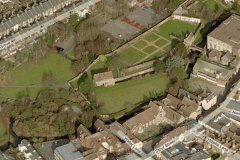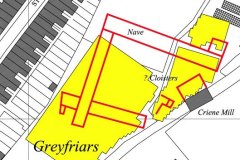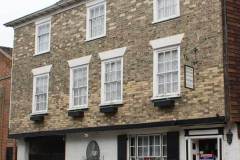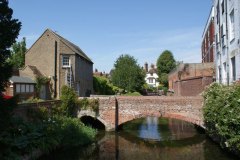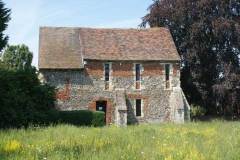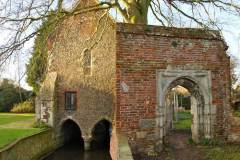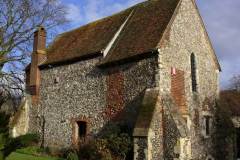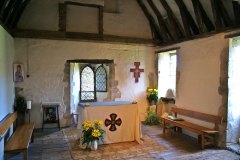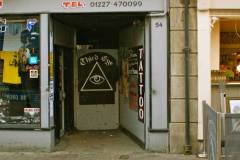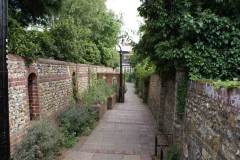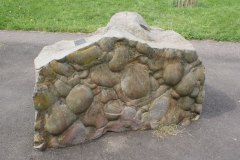Introduction
Greyfriars is an unexpected haven of peace and tranquility right in the heart of the city (Image 1). The entrance (a small charge applies) is from a shop front on St Peter’s Street. It was the site of an extensive friary (Image 2) between two arms of the River Stour, but now only a small chapel bridging the river remains, surrounded by open meadows and lawns.
History
The Grey Friars, or Friars Minor, were founded by Francesco Bernadone of Assisi in 1208 to serve the poor of rapidly growing urban populations. They were a mendicant (begging) order who sought to teach through the example of their simple lives of poverty and humility. They first arrived in England via Dover in 1224 and four of them stayed in Canterbury to establish their house. They were initially accommodated behind a school hall at Poor Priests and subsequently at a chapel on what is now known as Binnewith island, just behind the hospital. Eventually the order were directed by the Pope to acquire property to support their mission and in Canterbury they acquired 18 acres of marshland to the south and west of Binnewith island, including part of the route of the original Watling Street to London which had long fallen into disuse due to flooding. This land was was drained for agriculture and a large stone friary built between 1267 and 1325, although the site was vested in the city as the Friars could not own property . The order suffered badly from the Black Death in the mid 14th century and the friary closed with the dissolution of the monasteries in 1538. The site then passed through many hands and most of the buildings, including the east and north gates, were demolished. The remaining exception was one spanning the River Stour, which was probably originally a mill but later possibly the residence of the Master or a guest house. It was later a goal, provided accommodation for the Huguenots, in the 19th century it was a tea garden and in the 20th century a market garden. In 1959 it was sold to the Dean and Chapter of Canterbury and is now used as a chapel by the Anglican Franciscan movement based in Stour Street. A service is held every Wednesday at 1130. Their web site provides more information on the movement and the history of Greyfriars: Here
What to see:
- The inconspicuous access in Stour Street underneath the Greyfriars guest house (Image 3)
- The view of Assisi cottage and the broad spanbridge from the access bridge to Binnewith island (Image 4).
- The chapel viewed across the meadow of Binnewith (within the willows) island (Image 5).
- The chapel bridging river with central column (possibly from the cathedral following 12th century fire) and from south (Images 6 & 7).
- The interior of chapel (Image 8).
- Cokyn’s Lane forms the western edge of the site and is now inaccessible, but was once the road extension of the walking place, a feature unique to Franciscan churches between the chancel and nave. The wall of the lane still contains the remains of the chancel screen. The end of the road once terminated in a north gate to the friary (demolished 1595), now only a derelict entrance (Image 9).
- The modern Greyfriars passage (Image 10) was once another entrance to the friary via a ford and is accessible from a path adjacent to the Poor Priests hospital. It ontains an erratic stone commemorating the construction of the path (Image 11).
Access: For latest information on access to the gardens and/or the neighbouring Eastbridge Hospital please click Here.
Sources: Taylor (2003)
SR

